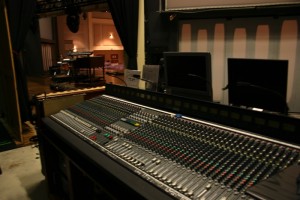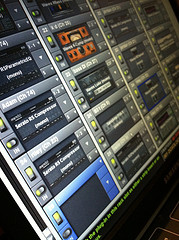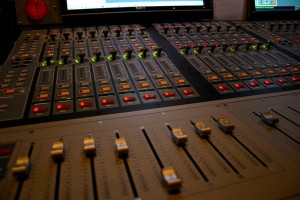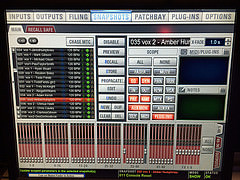
Recalling Some Monitor Mixes
A question came up recently on Twitter on whether there is a way to store preset monitor mixes on VENUE. This is actually something I’ve been experimenting with this year so I guess the answer is this can “sort-of” be done, but there’s not an easy solution. Some of the newer digital consoles I’m seeing on the market are offering some easier ways to do this, but even with the ability I don’t think it will work for everybody. So let’s explore this a bit, and then I’ll get into the nitty-gritty on what I’m doing with the Avid VENUE.
If your situation is like mine, you have a pickup band. For those unfamiliar with the term, a pickup band is basically a group of musicians who get put together for a limited time. In our case, that limited time is our Sunday service so every week we have a different group of musicians. Most of the musicians are familiar to us and have played on our stages before, but the specific players change every week. If you are working with the same lineup of musicians every week, none of this is going to apply.
I started experimenting with storing mixes as best as I could in order to save time and help with soundchecks, and the results have been mixed. Regardless of what kind of console you’re using, let’s talk about why this might and might not work.
For starters, a mix is heavily reliant on gain staging. When our monitor engineers start their mix to each musician, they set that musician’s input fader at unity and the send to their mix at unity. Then gain is turned up until the musician is happy. Some folks may cringe at this method, but this is actually a tried-and-true method those of us who grew up in the analog world learned. Plus, in most cases, this gets a nice healthy signal level on that input.
However, I have seen issues in this approach at monitors due to varying impedance levels on different models of custom in-ears. Not all in-ears have the same impedance, and that can have an effect on gain staging. Most musicians like to keep their packs at a healthy, yet modest level so they can maintain overall level control of their mixes; this is the same idea as us keeping our faders near unity. But when a musician’s in-ears are more sensitive, they may require less gain to drive them to a comfortable level when their pack’s level is set where it’s comfortable to adjust.
There are different and arguably better ways this kind of gain staging issue should be dealt with in order to keep a healthy input level. However, in my world I’ve found that it’s a lot easier to just deal with it on the input because changing up gain staging in other areas such as the console’s mix output or transmitter sensitivity tends to cause problems in the following weeks because those settings tend to be deeper in equipment and often get overlooked by the next monitor crew until it’s too late.
Anyway, the point I want to make is when you’re trying to make mix presets you need to have consistent gain staging on all your inputs so that the gain of each instrument is consistent week-to-week. If one guitar player’s signal level is usually around unity and another’s is 10 dB down from that, a preset mix will not compensate for that difference. I hope that makes sense.
Another issue comes up because mixes are not just based on signal levels. Tonality is a very big part of the mix as well. The tonality differences between two different lead guitar players or keyboard patches or bass guitars can be enough to change someone’s mix.
Whether it’s monitors, FOH, or the studio, one way to think of a mix is as a jigsaw puzzle with the different instruments being the pieces. I use things like level, dynamics processing, and EQ to shape each of those pieces so that they all fit together into a final picture. However, no two pieces are ever exactly alike so when you swap out one piece for another, the new piece won’t exactly fit the same way as the old one. Guitar players all have their own tones and sounds. Keyboard players all have their own tones and sounds. Even drummers on the same drum kit tuned the same way will sound different. In my early days of digital console use I used to try and store presets for each musician at FOH, but they never worked because a musician’s sound is as much a part of their own creation as the sounds that are around it in the mix.
The point I want to make is, your mileage may be limited if you try and do entire presets of mixes. That said, I have found some benefits for trying to store mixes.
The biggest win is we can get each musician’s gain staging and/or EQ pre-dialed to themselves. This is proving especially helpful with more complicated instruments such as drums. We always start our soundchecks with the drums, but I have seen drummers walk in and be ready to go after doing a very quick soundcheck since implementing this. Any tweaks to the drum kit mix are also pretty minor and quick as a result.
Minor wins include instrument panning. Every musician wants stuff in their mixes panned differently. By getting that stored ahead of time, it cuts out a step during soundcheck. Programming the console each week might also be a little faster since my recall workflow automatically labels a lot of things for me.
There might be some other little benefits, but as you can see this isn’t necessarily earth-shattering or game changing. I have seen it speed up soundchecks at times, but I’ve also see it slow things down so I’m still a little bit on the fence if this is actually a better method of working than our traditional way of pre-dialing mixes. At a minimum, I would keep the drum mixes, though, because they typically seem to take the most time to dial in.
So let’s get into VENUE specifics. I’ve been looking at this as a way to store custom pre-dialed mixes for musicians so I think of these are starting points, but not final mixes. I’m accomplishing this using snapshots.
Each musician that plays on our East Auditorium stage gets his/her own snapshot. On Monday or Tuesday I’ll take the previous Sunday’s show file and create a new snapshot for anyone new to the stage that week while also updating existing snapshots for musicians who had a really good day. Each snapshot is named first with that player’s role followed by their name so I can keep them all sorted to which mix they were on. With that housekeeping done, I have a snapshot saved that basically wipes the desk back to our default monitor mix start position with mixes pre-dialed based on our traditional method. Then I overwrite our template so that I have the new library of mixes stored in the template. This way we can start a rehearsal either from our traditional position or with the custom pre-dials recalled.
Simple so far. Recall is where it gets complicated.
Each VENUE snapshot stores a snapshot of the entire console’s settings with the exception of plugins. This is great for most applications, but when it comes to only recalling a specific aux-send or variable group mix it isn’t an ideal solution. So, for example, if I were to just recall each musician snapshot, I would not only recall that musician’s mix but every other mix and parameter on the console. So each time I recalled a mix snapshot, it would wipe the desk. There is a way around this using VENUE’s snapshot Scope and Recall Safe’s.
To start with, each musician’s snapshot has the following parameters in Scope: EQ, DYN, PRE, NAME, AUX MON, and PLUG-INs. These are used to recall specific settings for that musician such as their pre-amp settings, naming, and specific plugin settings. For example, some of our drummers have specific reverb and compression tastes so those settings are stored in the snapshot. Input and Output naming also gets stored here. Inputs for music specific inputs are also Scoped on the fader Inputs along with their specific mix Aux masters on the Outputs tab.
To prevent recalling things for every instrument and mix on the console, I make use of the console’s Recall Safes. I typically have everything safe’d on the entire console except for FADER, MUTE, and AUX MON on the Input safes. I started doing this when we installed the console so that in the event that we want/need snapshots for something, our engineers can be very specific in which mixes have snapshots recalling.
Next I created custom Recall Safe Scope Sets for each monitor mix. These custom sets turn off the recall safe settings for Mic Pre’s, HPF, EQ and Dynamics settings, and the input name on the Inputs side for that musician’s specific instrument(s). On the outputs side, the Scope Set turns the safe’s off for CH SENDS, OUT, and NAME. So these safe sets basically recall the input settings for a musician, label their input(s), recall the relative aux-send levels and panning for their entire mix, and then label their output on the console with their name.
Now, while it was a little complicated to setup, it’s actually not so bad in practice. If I want to load someone’s pre-dial settings, I select the Scope Set for their position(ex. drums), select their personal snapshot, and hit recall. I wish it was as simple as just recalling the snapshot, but it’s still not that many steps.
If you’ve got any questions about any of this, though, please feel free to add them in the comments below.


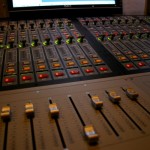 Previous Post
Previous Post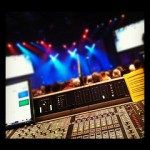 Next Post
Next Post